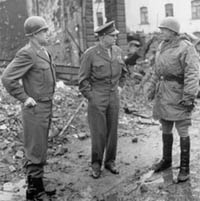|
|
|
 |
|
|
History
of German-American Relations > |
|
Neutrality was the official American response up to the outbreak of war in Europe in 1939. Legislation, enacted from 1935 to 1937, had prohibited trade with or credit to any of the warring nations. With the fall of France and the air war against Britain in 1940, the debate intensified between those who favored joining the war affort and the isolationists. The United States joined Canada in a Mutual Board of Defense, and aligned with the Latin American republics in extending collective protection to the nations in the Western Hemisphere. Congress voted immense sums for rearmament and in early 1941 approved the Lend-Lease Program, which enabled President Roosevelt to transfer arms and equipment to any nation (notably Great Britain, the Soviet Union and China) deemed vital to the defense of the United States. By 1941, there was an undeclared war between the United States and Germany in the Atlantic -- with U.S. warships protecting supply convoys from attacks by German submarines. On December 7, 1941, the Japanese bombed the U.S. Pacific fleet at Pearl Harbor, Hawaii. On December 8, Congress declared a state of war with Japan; three days later its allies, Germany and Italy, declared war on the United States. The western Allies decided that their essential military effort was to be concentrated in Europe. As a result of Germany's strong land forces, however, Great Britain and the United States postponed a cross-channel attack until June 1944. On D-Day, June 6, 1944, Allied forces landed in Normandy. On August 25, Paris was liberated. By February and March 1945, troops advanced into Germany and on May 7, Germany surrendered. The Allies insisted on an unconditional surrender. Roosevelt also considered, but then backed away from, the enactment of the 1944 Morgenthau Plan which envisaged the permanent dismemberment of Germany and the destruction of all heavy industry. See also:
|
||
|
Texts
are abridged from U.S. State Department IIP
publications and other U.S. government materials. |
||
| What
kind of information materials are available?
CD: These documents are available in fulltext format on the About the USA CD-ROM. Teachers: Request a copy for classroom use. L: Selected documents are available in German as well as other languages, including Arabic, Chinese, French, Spanish, Persian and Turkish. |
DISCLAIMER
Any reference obtained from this server to a specific commercial product, process, or service does not constitute or imply an endorsement by the United States Government of the product, process, or service, or its producer or provider. The views and opinions expressed in any referenced document do not necessarily state or reflect those of the United States Government. |

